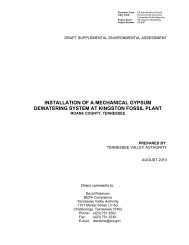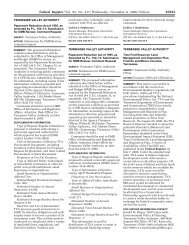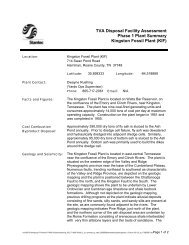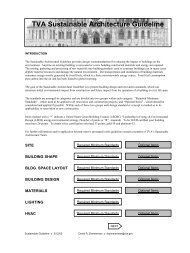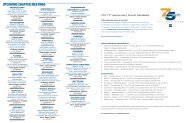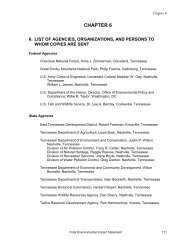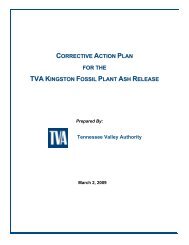Chapter 4: Supporting Information - Tennessee Valley Authority
Chapter 4: Supporting Information - Tennessee Valley Authority
Chapter 4: Supporting Information - Tennessee Valley Authority
You also want an ePaper? Increase the reach of your titles
YUMPU automatically turns print PDFs into web optimized ePapers that Google loves.
<strong>Chapter</strong> 4<br />
4. SUPPORTING INFORMATION<br />
4.1 List of TVA Preparers and Contributors<br />
Judith P. Bartlow, Senior Natural Areas Specialist, River System Operations and Environment,<br />
Resource Stewardship, Watershed Technical Services, Regional Natural Heritage Project,<br />
Norris, <strong>Tennessee</strong> (Retired)<br />
Patricia Bernard-Ezzell, Historian, River System Operations and Environment, Resource<br />
Stewardship, Watershed Technical Services, Cultural Resources, Norris, <strong>Tennessee</strong><br />
Robert E. Buchanan, Jr., Program Administrator, River Operations, Navigation, Navigation<br />
and Structures Engineering, Knoxville, <strong>Tennessee</strong><br />
J. Leo Collins, Senior Botanist, River System Operations and Environment, Resource<br />
Stewardship, Watershed Technical Services, Regional Natural Heritage Project, Norris,<br />
<strong>Tennessee</strong><br />
Chellie J. Cook, Clerk/Editor, River System Operations and Environment, Resource<br />
Stewardship, Northeast Region, Clinch-Powell Watershed Team, Norris, <strong>Tennessee</strong><br />
Stephen D. Cottrell, Wildlife Biologist, River System Operations and Environment, Resource<br />
Stewardship, Northeast Region, Norris, <strong>Tennessee</strong><br />
Dennis T. Curtin, Program Administrator, River System Operations and Environment, Resource<br />
Stewardship, Watershed Technical Services, Regional Natural Heritage Project, Norris,<br />
<strong>Tennessee</strong><br />
Stanford E. Davis, Environmental Scientist, River System Operations and Environment,<br />
Resource Stewardship, Northeast Region, Morristown, <strong>Tennessee</strong><br />
Janice F. Dockery, Editorial Clerk, River System Operations and Environment, Resource<br />
Stewardship, Watershed Technical Services, <strong>Information</strong> and Technical Support Services,<br />
Chattanooga, <strong>Tennessee</strong><br />
Harold M. Draper, NEPA Specialist, NEPA Administration, Environmental Policy and<br />
Planning, Knoxville, <strong>Tennessee</strong><br />
James H. Eblen, Economist (Contractor), River System Operations and Environment, Knoxville,<br />
<strong>Tennessee</strong><br />
Frank B. Edmonson, Senior Land Use Specialist, River System Operations and Environment,<br />
Resource Stewardship, Northeast Region, Upper Holston Watershed Team, Kingsport,<br />
<strong>Tennessee</strong><br />
Environmental Assessment 101
Norris Reservoir Land Management Plan<br />
Joe C. Feeman, Forester, River System Operations and Environment, Resource Stewardship,<br />
Northeast Region, Norris, <strong>Tennessee</strong><br />
Linda J. Fowler, Land Use Specialist, River System Operations and Environment, Resource<br />
Stewardship, Northeast Region, Clinch-Powell Watershed Team, Norris, <strong>Tennessee</strong><br />
Nancy D. Fraley, Natural Areas Specialist, River System Operations and Environment, Resource<br />
Stewardship, Watershed Technical Services, Regional Natural Heritage Project, Norris,<br />
<strong>Tennessee</strong><br />
David B. Harrell, Land Use Specialist, River System Operations and Environment, Resource<br />
Stewardship, Northeast Region, Clinch-Powell Watershed Team, Norris, <strong>Tennessee</strong><br />
Debra L. Heck, Land Use Specialist, River System Operations and Environment, Resource<br />
Stewardship, Northeast Region, Clinch-Powell Watershed Team, Norris, <strong>Tennessee</strong><br />
Travis Hill Henry, Senior Terrestrial Zoologist, River System Operations and Environment,<br />
Resource Stewardship, Watershed Technical Services, Regional Natural Heritage Project,<br />
Norris, <strong>Tennessee</strong><br />
A. Eric Howard, Archaeologist, River System Operations and Environment, Resource<br />
Stewardship, Watershed Technical Services, Cultural Resources, Norris, <strong>Tennessee</strong><br />
Deborah K. Hubbs, Watershed Specialist, River System Operations and Environment, Resource<br />
Stewardship, Northeast Region, Clinch-Powell Watershed Team, Norris, <strong>Tennessee</strong><br />
George M. Humphrey, Land Use Specialist/Recreation Planner, River System Operations and<br />
Environment, Resource Stewardship, Northeast Region, Norris, <strong>Tennessee</strong><br />
Jimmie J. Kelso, Environmental Scientist, Environmental Research and Services, Muscle<br />
Shoals, Alabama<br />
Tere C. McDonough, Manager, River System Operations and Environment, Resources<br />
Stewardship, Northeast Region, Clinch-Powell Watershed Team, Norris, <strong>Tennessee</strong><br />
Roger A. Milstead, Technical Specialist, River Operations, Knoxville, <strong>Tennessee</strong><br />
Jason M. Mitchell, Terrestrial Zoologist (Contractor), River System Operations and<br />
Environment, Resource Stewardship, Watershed Technical Services, Regional Natural Heritage<br />
Project, Norris, <strong>Tennessee</strong><br />
Norris A. Nielsen, Meteorologist, Environmental Research and Services, Muscle Shoals,<br />
Alabama<br />
T. Shannon O’Quinn, Land Use Specialist, River System Operations and Environment,<br />
Resource Stewardship, Northeast Region, Clinch-Powell Watershed Team, Kingsport,<br />
<strong>Tennessee</strong><br />
102<br />
Environmental Assessment
<strong>Chapter</strong> 4<br />
George E. Peck, Aquatic Biologist, River System Operations and Environment, Resource<br />
Stewardship, Watershed Technical Services, Norris, <strong>Tennessee</strong><br />
Samuel C. Perry, Project Leader, River System Operations and Environment, Resource<br />
Stewardship, Watershed Technical Services, Site Planning and Design, Norris, <strong>Tennessee</strong><br />
(Retired)<br />
Larry R. Pounds, Botanist (Contractor), River System Operations and Environment, Resource<br />
Stewardship, Watershed Technical Services, Regional Natural Heritage Project, Norris,<br />
<strong>Tennessee</strong><br />
Tim D. Pruitt, Land Use Specialist, River System Operations and Environment, Resource<br />
Stewardship, Clinch-Powell Watershed Team, Norris, <strong>Tennessee</strong><br />
Wayne H. Schacher, Zoologist/Wildlife Biologist (Contractor), River System Operations and<br />
Environment, Resource Stewardship, Watershed Technical Services, Regional Natural Heritage<br />
Project, Norris, <strong>Tennessee</strong> (Retired)<br />
Peggy W. Shute, Senior Aquatic Biologist/Project Leader, River System Operations and<br />
Environment, Resource Stewardship, Watershed Technical Services, Regional Natural Heritage<br />
Project, Norris, <strong>Tennessee</strong><br />
Deborah K. Smith, Senior Computer Technician, River System Operations and Environment,<br />
Resource Stewardship, Geographic <strong>Information</strong> Systems, Norris, <strong>Tennessee</strong><br />
Charles R. Tichy, Historical Architect, River System Operations and Environment, Resource<br />
Stewardship, Watershed Technical Services, Cultural Resources, Norris, <strong>Tennessee</strong><br />
William B. Tidwell, Land Use Agent, River System Operations and Environment, Resource<br />
Stewardship, Northeast Region, Clinch-Powell Watershed Team, Norris, <strong>Tennessee</strong><br />
Julie S. Tindell, Watershed Specialist, River System Operations and Environment, Resource<br />
Stewardship, Northeast Region, Clinch-Powell Watershed Team, Norris, <strong>Tennessee</strong><br />
Cheryl V. Ward, Project Manager-Environmental, River System Operations and Environment,<br />
Resource Stewardship, Watershed Technical Services, Projects and Services, Norris, <strong>Tennessee</strong><br />
James F. Williamson, Jr., NEPA Projects Manager, River System Operations and Environment,<br />
Resource Stewardship, Watershed Technical Services, Projects and Services, Norris, <strong>Tennessee</strong><br />
Richard W. Yarnell, Archaeologist, River System Operations and Environment, Resource<br />
Stewardship, Watershed Technical Services, Cultural Resources, Norris, <strong>Tennessee</strong><br />
Environmental Assessment 103
Norris Reservoir Land Management Plan<br />
4.2 List of Agencies and Organizations Consulted<br />
The draft EA was distributed to the following federal, state and local agencies, conservation<br />
organizations, and area public libraries and courthouses.<br />
Federal Agencies<br />
U.S. Geological Services<br />
U.S. Army Corps of Engineers<br />
U.S. Fish and Wildlife Service<br />
State Agencies<br />
<strong>Tennessee</strong> Department of Economic and Community Development<br />
<strong>Tennessee</strong> Wildlife Resources Agency<br />
<strong>Tennessee</strong> Department of Transportation<br />
<strong>Tennessee</strong> Department of Environment and Conservation<br />
Commissioner’s Office<br />
Division of Water Pollution Control<br />
Division of Air Pollution Control<br />
Division of Water Supply<br />
Division of Groundwater Protection<br />
Division of Natural Heritage<br />
Division of State Parks<br />
<strong>Tennessee</strong> Historical Commission<br />
<strong>Tennessee</strong> Commission of Indian Affairs<br />
<strong>Tennessee</strong> Division of Forestry<br />
Regional/Local Agencies<br />
Anderson County Chamber of Commerce<br />
Anderson County Tourism Council<br />
Campbell County Chamber of Commerce<br />
Claiborne County Chamber of Commerce<br />
Lake City Chamber of Commerce<br />
Oak Ridge Chamber of Commerce<br />
104<br />
Environmental Assessment
<strong>Chapter</strong> 4<br />
Conservation Organizations<br />
Campbell Outdoor Recreation Association<br />
<strong>Tennessee</strong> Conservation League<br />
National Wildlife Federation<br />
National Wild Turkey Federation<br />
Quail Unlimited<br />
Ducks Unlimited<br />
Soil Conservation District Board<br />
Friends of Cove Lake<br />
Friends of Big Ridge State Park<br />
Campbell County Soil Conservation<br />
Area Public Libraries and Courthouses<br />
Anderson County Courthouse<br />
Campbell County Courthouse<br />
Caryville Public Library<br />
Claiborne County Courthouse<br />
Clinton Public Library<br />
Grainger County Courthouse<br />
Jacksboro Public Library<br />
Knoxville City-County Building<br />
Knox County Public Library (Halls Branch)<br />
LaFollette Public Library<br />
Lake City Public Library<br />
Lawson McGhee Library (Knoxville)<br />
Norris Public Library<br />
Rutledge PublicLibrary<br />
Union County Courthouse<br />
Environmental Assessment 105
Norris Reservoir Land Management Plan<br />
Persons Consulted<br />
Altivene Adams<br />
Mr. Bryan Allen<br />
Ms. Katherine E. Andrews<br />
Mr. Jimmy B. Arnold<br />
Mr. B. Chris Arnold<br />
Ms. Lorretta Arwood<br />
B&B Straight Creek Boat Dock<br />
Mr. Lawrence M. Bailey<br />
Barge, Waggoner, Sumner, &<br />
Cannon, Inc.<br />
Mr. Alan Barrett<br />
Mr. Charles A. Bartlett<br />
Mr. Leon R. Beal<br />
Mr. J. Victor Bean<br />
Mr. Jake Beeler<br />
Mr. Dennis Blankemeyer<br />
May and Spencer Boardman<br />
Mr. Patrick Bowler<br />
Mr. Thomas W. Boyd<br />
Mr. Harry Bracy<br />
Mr. W. Lee Brame<br />
Mr. Lester Branham<br />
Mr. Willard T. Braswell<br />
Mr. Robert Brownlee<br />
Mr. Devoy Brunson<br />
Mr. James Burke<br />
Ms. Kathy Calvert<br />
Mr. Allan E. Cameron<br />
Mr. Jack Campbell<br />
Mr. Bill Cannon<br />
Mr. Dail R. Cantrell<br />
Mr. Benny Carden<br />
Mr. David J. Cassady<br />
Mr. Raymond Casta<br />
Ms. Thresa Champagne<br />
Mr. Donn Claiborne<br />
Mr. Wayne Coffey<br />
Ms. Bette W. Collier<br />
Mr. Richard E. Cook<br />
Mr. David B. Cook<br />
Mr. Robert R. Croley<br />
Mr. Danny Crowley<br />
Mr. William F. Crowley<br />
Mr. Dwight Crutchfield<br />
Terry Cunningham<br />
Mr. Rick Daugherty<br />
Mr. Richard P. Davis<br />
Marion Davis<br />
Mr. Bill Dean<br />
Deer Lake Condominiums<br />
Mr. Dale Dietrich<br />
I. T. Dudley<br />
Ms. Peggy S. Duncan<br />
Mr. Ted H. Ellis III<br />
Sam and Micky Etnier<br />
Mr. Larry K. Evans<br />
Mr. Daniel N. FaForce, Sr.<br />
Clinton Utilities Board<br />
Mr. Michael V. Ferraro<br />
Mr. Eugene Flaute<br />
Ms. Carol Forman<br />
Mr. Larry Gibney<br />
Mr. Terrill G. Gillespie<br />
Adrian M. Gonzalez<br />
Marcell Goodwin<br />
Mr. Lester Hacker<br />
Mr. Gerald G. Hamman, Jr.<br />
Mr. Mark W. Hausfeld<br />
Dave and Jan Henry<br />
Mr. R. Ellis Hill<br />
Mr. Robert Hilty<br />
Ms. Carol Houff<br />
Ijams Nature Center<br />
Mr. Claude Isaacs<br />
Mr. Ernest L. Jeffcoat<br />
Mr. Jack Jenkins<br />
Mr. Jay R. Jira<br />
Mr. Mike Jolly<br />
Mr. Allan Jones<br />
Mr. Michael Juscius<br />
Mr. James M. Kain<br />
Ron and Neva Kitts<br />
Mr. John B. Kopp<br />
Mr. Bill Kornrich<br />
LaFollette Utilities<br />
Mr. Charles E. Lawson<br />
Mr. Al Leinart<br />
Mr. J. P. Light<br />
Mr. David L. Linn<br />
Mr. Gordon Livingston<br />
Mr. Paul Longmire<br />
Mr. Howard L. Loveless<br />
Mr. William Malone<br />
Mr. Calloway A. Massengill<br />
Mr. Ray F. Mauger<br />
Mr. Mack Mauley<br />
Mr. David D. Maxwell<br />
Mr. James McIntosh<br />
Mr. James R. McMillen<br />
Mr. George McNeely<br />
Mr. James McReynolds<br />
Mr. Greg McWhorter<br />
Mr. John K. Mitchell<br />
Ms. Barbara Monroe<br />
Mr. Nicholas J. Munafo<br />
Mr. Dan H. Nishwitz<br />
Mr. Michael Nixon<br />
Mr. William C. Noell, Jr.<br />
Mr. Patrick O'Christie<br />
Tom and Deb Orlin<br />
Ms. Linda Osborne<br />
Mr. John Ozier<br />
Mr. John Perry<br />
Ms. Bonnie Peters<br />
Mr. Richard Phillips<br />
Lewis and Phyllis Phillips<br />
Powell <strong>Valley</strong> Electric Cooperation<br />
Mr. Rob Powers<br />
Mr. James C. Price<br />
Mr. Paul Purcell<br />
Mr. Steve Pyatt<br />
Mr. Fred H. Redmond<br />
Ms. Marcy Reed<br />
Mr. Joseph A. Reed, Jr.<br />
Mr. Jason Reeves<br />
Mr. Larry Dean Reeves<br />
Ms. Maribeth Richter<br />
Four Seasons Properties<br />
Mr. Paul Sharp<br />
Mr. Jerry L. Shepherd<br />
Mr. Ira Smith<br />
Angela and Tim Snow<br />
Ms. Patricia Snyder<br />
Mr. Robert Spurling<br />
Ms. Sharon Startup<br />
Mr. Jeff Stephens<br />
Mr. Tom Strottman<br />
Mr. Guy Sturms<br />
S. R. Sumner<br />
Swiger and Son<br />
Dennis and Cliff Swett<br />
Southern Lifestyles<br />
Mr. Tom Taylor<br />
Mr. Jerry Tenbrook<br />
Mr. Paul Thompson<br />
C. A. Torbett<br />
Mr. Jerry Trimbach<br />
Mr. Steve Turpin<br />
Mr. Kermit Violet<br />
Mr. Gerald P. Wagner<br />
Ms. Merry Jane Walsh<br />
Ms. Barbara A. Walton<br />
Mr. Gary West<br />
Mr. Jim Wilbanks<br />
Mr. Edd Willoughby<br />
Mr. Roy Ted Wilson<br />
Mr. James M. Woods<br />
Mr. Ralph J. Wright<br />
Mr. Curtis Yeary<br />
Mr. John Young<br />
106<br />
Environmental Assessment
<strong>Chapter</strong> 4<br />
4.3 Glossary<br />
100-year Floodplain<br />
Agricultural Licensing<br />
Attainment Areas<br />
Benthic<br />
Cumulative Impacts<br />
Dam Reservation<br />
Direct Impacts<br />
Dissolved Oxygen<br />
Drawdown Zone<br />
Dredging<br />
Embayment<br />
Emergent Wetland<br />
Endangered Species<br />
Fecal Coliform<br />
Floodplains<br />
The area inundated by the 1 percent annual chance (or 100-year) of flooding.<br />
Some parcels or portions of parcels designated for other purposes or uses may<br />
also be suitable for interim agricultural licensing. These parcels have been<br />
identified using the criteria contained in the January 1999 Agriculture Land<br />
Licensing EA. Land with extreme erosion potential may not be licensed for<br />
agricultural use unless erosion and sediment controls, including the use of<br />
BMPs, can be successfully implemented. Further investigation and/or<br />
mitigation of adverse impacts to natural or cultural resources may be required<br />
prior to approval of license agreements.<br />
Those areas of the U.S. that meet National Ambient Air Quality Standards as<br />
determined by measurements of air pollutant levels.<br />
Refers to the bottom of a stream, river, or reservoir.<br />
Impacts which result from the incremental impact of the action when added to<br />
other past, present, and reasonably foreseeable actions, regardless of what<br />
agency or person undertakes such actions (40 C.F.R. § 1508.7).<br />
Land generally maintained in a park-like setting by TVA to protect the integrity<br />
of the dam structure, hydroelectric facilities, and navigation lock. The<br />
reservation also provides for public visitor access to the TVA dam facilities and<br />
recreation opportunities, such as public boat access, bank fishing, camping, and<br />
picnicking.<br />
Effects which are caused by the action and occur at the same time and place<br />
(40 C.F.R. § 1508.4).<br />
The oxygen dissolved in water necessary to sustain aquatic life. It is usually<br />
measured in milligrams per liter or parts per million.<br />
Area of reservoirs exposed between full summer pool and minimum winter<br />
pool levels during annual drawdown of the water level for flood control.<br />
The removal of material from an underwater location, primarily for deepening<br />
harbors and waterways.<br />
A bay or arm of the reservoir.<br />
Wetlands dominated by erect, rooted herbaceous plants, such as cattails and<br />
bulrush.<br />
Any species in danger of extinction throughout all or a significant portion of its<br />
range or territory.<br />
Common intestinal bacteria in human and animal waste.<br />
Any land area susceptible to inundation by water from any source by a flood of<br />
selected frequency. For purposes of the National Flood Insurance Program, the<br />
floodplain, as a minimum, is that area subject to a 1 percent or greater chance<br />
of flooding (100-year flood) in any given year.<br />
Environmental Assessment 107
Norris Reservoir Land Management Plan<br />
Flowage Easement Tracts<br />
Forecast System<br />
Fragmentation<br />
Indirect Impacts<br />
Macroinvertebrates<br />
Mainstream Reservoirs<br />
Marginal Strip<br />
Maximum Shoreline<br />
Contour<br />
National Ambient Air<br />
Quality Standards<br />
National Environmental<br />
Policy Act<br />
Neotropical Migrant Birds<br />
Physiographic Provinces<br />
Non-TVA lakeshore properties where TVA has (1) the right to flood the land as<br />
part of its reservoir operations, (2) no rights for vegetation management, and<br />
(3) the authority to review plans for the construction of structures under Section<br />
26a of the TVA Act.<br />
The process used for planning the use of TVA public land. TVA staff would<br />
provide a record of actual and prospective uses indicated for particular<br />
properties. A Forecast System record book was prepared for each TVA<br />
reservoir to serve as a general guide for use or development to benefit TVA<br />
staff interests and the local or regional economy. Decisions on the best use of<br />
the property were made, using internal agency expertise. The new land use<br />
planning process will eventually replace the Forecast System as the mechanism<br />
for identifying acceptable uses of TVA public land. A major difference<br />
between the two methods is the involvement of the public in the planning<br />
process.<br />
The process of breaking up a large area of relatively uniform habitat into one or<br />
more smaller, disconnected areas.<br />
Effects which are caused by the action and are later in time or farther removed<br />
in distance but are still reasonably foreseeable (40 C.F.R. § 1508.4).<br />
Aquatic insects, snails, and mussels whose species, genus, etc., can be<br />
determined with the naked eye.<br />
Impoundments created by dams constructed across the <strong>Tennessee</strong> River.<br />
The narrow strip of land owned by TVA between the water’s edge and the<br />
adjoining private property, on which the property owner may construct private<br />
water use facilities upon approval of plans by TVA.<br />
An elevation typically 5 feet above the top of the gates of a TVA dam. It is<br />
often the property boundary between TVA marginal strip property and<br />
adjoining private property.<br />
Uniform, national air quality standards established by the Environmental<br />
Protection Agency that restrict ambient levels of certain pollutants to protect<br />
public health (primary standards) or public welfare (secondary standards).<br />
Standards have been set for ozone, carbon monoxide, particulate, sulfur<br />
dioxide, nitrogen, nitrogen dioxide, and lead.<br />
Legislation signed into law in 1970 which, among other provisions, requires<br />
U.S. government agencies to prepare environmental reviews on proposed<br />
policies, procedures, plans, approvals, and other proposed federal actions.<br />
Approval of a private water use facility or sale of an easement to use federal<br />
land are examples of federal actions subject to NEPA.<br />
Birds which nest in the U.S. or Canada and migrate to spend the winter in<br />
Mexico, Central America, the Caribbean, or South America.<br />
General divisions of land with each area having characteristic combinations of<br />
soil materials and topography.<br />
108<br />
Environmental Assessment
<strong>Chapter</strong> 4<br />
Prime Farmland<br />
Reservoir Operations<br />
Tracts<br />
Riparian Zone<br />
Riprap<br />
Riverine<br />
Sawtimber<br />
Section 26a Review<br />
Process<br />
Scrub-shrub<br />
Shoreline<br />
Shoreline Management<br />
Zone<br />
Stratification<br />
Generally regarded as the best land for farming. These areas are flat or gently<br />
rolling and are usually susceptible to little or no soil erosion. Prime farmland<br />
produces the most food, feed, fiber, forage, and oilseed crops with the least<br />
amount of fuel, fertilizer, and labor. It combines favorable soil quality,<br />
growing season, and moisture supply and, under careful management, can be<br />
farmed continuously and at a high level of productivity without degrading<br />
either the environment or the resource base. Prime farmland does not include<br />
land already in or committed to urban development, roads, or water storage.<br />
Prior to the reservoir land planning process (1979), TVA made land use<br />
decisions based on a Forecast System approach. The term Reservoir<br />
Operations was used to identify specific TVA public land where the field<br />
district manager had been given the authority by the Board to approve or deny<br />
minor shoreline alterations requested by adjacent private landowners. In cases<br />
where property owners had no rights of ingress or egress across TVA property,<br />
but owned land adjacent to a Reservoir Operations tract, the agency could<br />
provide a letter permit allowing the property owner the right to construct<br />
preapproved private shoreline improvements.<br />
During TVA’s formative years (1930s and 1940s) when public land was more<br />
abundant, TVA wanted to assist in providing recreation access to the reservoir<br />
wherever feasible. Reservoir Operation tracts provide this opportunity and are<br />
disbursed throughout the entire TVA reservoir system.<br />
An area of land that has vegetation or physical characteristics reflective of<br />
permanent water influence. Typically, a streamside zone or shoreline edge.<br />
Stones placed along the shoreline for bank stabilization and other purposes.<br />
Having characteristics similar to a river.<br />
Refers to the size of a tree. A hardwood tree that is 11 inches or greater in<br />
diameter is classified as sawtimber size. Pine trees 9 inches or greater in<br />
diameter are classified as sawtimber size.<br />
Section 26a of the TVA Act requires review and approval of plans for<br />
obstructions, such as docks, fills, bridges, outfalls, water intakes, and riprap<br />
before they are constructed across, in, or along the <strong>Tennessee</strong> River and its<br />
tributaries. Applications for this approval are coordinated appropriately within<br />
TVA and USACE. The appropriate state water pollution control agency must<br />
also certify that the effluent from outfalls meets the applicable water quality<br />
standards.<br />
Woody vegetation less than about 20 feet tall. Species include true shrubs,<br />
young trees, and trees or shrubs that are small or stunted because of<br />
environmental conditions.<br />
The line where the water of a TVA reservoir meets the shore when the water<br />
level is at the normal summer pool elevation.<br />
A barrier of permanent vegetation established or left undisturbed around a<br />
reservoir in order to buffer the adverse impacts resulting from development and<br />
increased human activity.<br />
The seasonal layering of water within a reservoir due to differences in<br />
temperature or chemical characteristics of the layers.<br />
Environmental Assessment 109
Norris Reservoir Land Management Plan<br />
Substrates<br />
Summer Pool Elevation<br />
Tributary Reservoirs<br />
Turbidity<br />
Unit Plan<br />
Upland<br />
Wetlands (as defined in<br />
TVA Environmental<br />
Review Procedures)<br />
The base or material to which a plant is attached and from which it receives<br />
nutrients.<br />
The normal upper level to which the reservoirs may be filled. Where<br />
storage space is available above this level, additional filling may be made<br />
as needed for flood control.<br />
Impoundments created by dams constructed across streams and rivers that<br />
eventually flow into the <strong>Tennessee</strong> River.<br />
All the organic and inorganic living and nonliving materials suspended in a<br />
water column. Higher levels of turbidity affect light penetration and<br />
typically decrease productivity of water bodies.<br />
In 1997 TVA began managing its resources on reservoir land through a<br />
two-tier process which includes (1) Land Management Plans - a strategic<br />
look at all of the land on a reservoir to determine what is the best use (zone)<br />
and (2) Unit Plans - a tactical plan on a designated management unit which<br />
outlines a 25-year management (implementation) program for parcels zoned<br />
for natural resource conservation and sensitive resource management in the<br />
Land Management Plans. Unit plans, which include a management plan<br />
and EA, are developed with stakeholder involvement and include a number<br />
of alternatives. Management activities are categorized into wildlife habitat,<br />
forest, natural areas, and public use. Currently there are two completed<br />
plans on Norris Reservoir, Davis Creek Management Unit, 1562 acres<br />
(TVA, 2000a) and Fullerton Bend Management Unit, 2492 acres (TVA,<br />
2001); and one draft plan, Lone Mountain Management Unit,<br />
approximately 4000 acres, scheduled to be completed in 2002.<br />
The higher parts of a region, not closely associated with streams or lakes.<br />
“Wetlands are those areas inundated by surface or ground water with a<br />
frequency sufficient to support and under normal circumstances do or<br />
would support a prevalence of vegetation or aquatic life that requires<br />
saturated or seasonably saturated soil conditions for growth and<br />
reproduction. Wetlands generally include swamps, marshes, bogs, and<br />
similar areas, such as sloughs, potholes, wet meadows, mud flats, and<br />
natural ponds.”<br />
110<br />
Environmental Assessment
<strong>Chapter</strong> 4<br />
4.4 Acronyms and Abbreviations<br />
APE<br />
Area of Potential Effect<br />
ARPA<br />
Archaeological Resources Protection Act<br />
Board<br />
TVA Board of Directors<br />
BMPs<br />
Best Management Practices<br />
CCC<br />
Civilian Conservation Corps<br />
cfs<br />
cubic feet per second<br />
CPWT<br />
Clinch-Powell Watershed Team<br />
CRM<br />
Clinch River Mile<br />
°F Degrees Fahrenheit<br />
DO<br />
dissolved oxygen<br />
EA<br />
Environmental Assessment<br />
EIS<br />
Environmental Impact Statement<br />
FPPA<br />
Federal Farmland Protection Policy Act<br />
FONSI<br />
Finding of No Significant Impact<br />
HUCs<br />
Hydrologic Unit Codes<br />
msc<br />
maximum shoreline contour<br />
msl<br />
mean sea level<br />
Loyston<br />
Loyston Point Recreation Area<br />
NEPA<br />
National Environmental Policy Act<br />
NHPA<br />
National Historic Preservation Act<br />
Norris Plan Norris Reservoir Land Management Plan<br />
NRHP<br />
National Register of Historic Places<br />
PA<br />
Programmatic Agreement<br />
Plan<br />
Reservoir Land Management Plan<br />
PRM<br />
Powell River Mile<br />
PSD<br />
Prevention of Significant Deterioration<br />
RVSMP<br />
Reservoir Vital Signs Monitoring Program<br />
SAHI<br />
Shoreline Aquatic Habitat Index<br />
SFI<br />
Sport Fishing Index<br />
Environmental Assessment 111
Norris Reservoir Land Management Plan<br />
SHPO<br />
SMI<br />
SMP<br />
SMZ<br />
Tactical Plan<br />
TDEC<br />
TMDL<br />
TVA<br />
TWRA<br />
USACE<br />
USDA<br />
USEPA<br />
USFWS<br />
State Historic Preservation Officer<br />
Shoreline Management Initiative<br />
Shoreline Management Policy<br />
Shoreline Management Zone<br />
Norris Dam Reservation Tactical Plan<br />
<strong>Tennessee</strong> Department of Environment and Conservation<br />
Total Maximum Daily Load<br />
<strong>Tennessee</strong> <strong>Valley</strong> <strong>Authority</strong><br />
<strong>Tennessee</strong> Wildlife Resources Agency<br />
U.S. Army Corps of Engineers<br />
U.S. Department of Agriculture<br />
U.S. Environmental Protection Agency<br />
U.S. Fish and Wildlife Service<br />
4.5 Literature Cited<br />
Amundsen, C. C. 1994. “Reservoir Riparian Zone Characteristics in the Upper <strong>Tennessee</strong> River<br />
<strong>Valley</strong>,” in: Wetlands of the Interior Southeastern United States. Kluwer Academic Press,<br />
pp. 273-297.<br />
Choate, J. R., J. K. Jones, Jr., and C. Jones. 1994. Handbook of Mammals of the South-Central<br />
States. LSU Press. Baton Rouge, Louisiana. 304 pp.<br />
Cordell, H. Ken. 1998. The National Survey on Recreation and the Environment. pp. 221-227.<br />
DuVall, Glyn. 1995. An Archaeological and Historic Assessment of the Route 1090 Bridge Over<br />
Hunting Creek (L.M.5.45), Union County, <strong>Tennessee</strong>. Submitted to Neel-Schaffer, Inc.,<br />
Nashville, <strong>Tennessee</strong>.<br />
El-Ashry, T. 1981. Memorandum to Those listed, Subject: Class Review of Certain<br />
Repetitive Actions in the 100-year Floodplain, Dated August 13, 1981.<br />
Etnier, D. A., and W. C. Starnes. 1993. The Fishes of <strong>Tennessee</strong>. The University of <strong>Tennessee</strong><br />
Press, Knoxville, <strong>Tennessee</strong>.<br />
Froeschauer, John, Peggy Froeschauer, and Charles Stripling. 1986. Archaeological Survey of<br />
State-Owned Lands. <strong>Tennessee</strong> Department of Conservation, Division of Archaeology, Report<br />
of Investigations No. 3. Nashville, <strong>Tennessee</strong>.<br />
112<br />
Environmental Assessment
<strong>Chapter</strong> 4<br />
Greene, Lance. 1995. Phase II Testing of Ten Archaeological Sites and Five Rock Shelters in<br />
the Proposed State Route 32 (U.S. Route 25E) Right-of-Way, from 0.8 km North of Indian<br />
Creek to 1.6 km North of the Powell River, Claiborne and Grainger Counties, <strong>Tennessee</strong>.<br />
Submitted by the University of <strong>Tennessee</strong> Transportation Center, Knoxville, <strong>Tennessee</strong>.<br />
Submitted to Neel-Schaffer Inc., Nashville, <strong>Tennessee</strong>.<br />
Greenwald, L. N. 1977. “Endangered and Threatened Wildlife and Plants. Final Threatened<br />
Status and Critical Habitat for Five Species of Southeastern Fishes.” Federal Register, Volume<br />
42, No. 175. Friday, September 9, 1977. 6 pp.<br />
Harvey, M. J. 1992. Bats of the Eastern United States. Arkansas Game and Fish<br />
Commission/United States Fish and Wildlife Service/<strong>Tennessee</strong> Technological University.<br />
46 pp.<br />
Hickman, Gary D. 1999. Sport Fishing Index (SFI) - A Method to Quantify Sport Fishing<br />
Quality. <strong>Tennessee</strong> <strong>Valley</strong> <strong>Authority</strong>, Resource Stewardship, Norris, <strong>Tennessee</strong>. Unpublished<br />
report. 24 pp.<br />
Juchniewicz, Joanne, Richard Alvey, Henry McKelway, Lance Greene, and Noeleen McIlvenna.<br />
1994. Phase I Archaeological Reconnaissance Survey for Cultural Resources in the Proposed<br />
State Route 32 Realignment Right-of-Way, Claiborne and Grainger Counties, <strong>Tennessee</strong>.<br />
Submitted by the University of <strong>Tennessee</strong> Transportation Center, Knoxville, <strong>Tennessee</strong>.<br />
Submitted to Chester IDE Associates, Inc., Nashville, <strong>Tennessee</strong>.<br />
Nicholson, C. P. 1997. Atlas of the Breeding Birds of <strong>Tennessee</strong>. The University of <strong>Tennessee</strong><br />
Press. Knoxville, <strong>Tennessee</strong>. 426 pp.<br />
Petranka, J. W. 1998. Salamanders of the United States and Canada. Smithsonian Institution<br />
Press. Washington, D.C. 587 pp.<br />
Pietak, Lynn, Ray Ezell, and Jeffrey Holland. 1999. Phase I Archaeological Survey of Norris<br />
Lake, Anderson, Campbell, Claiborne, Grainger, and Union Counties, <strong>Tennessee</strong> (Volumes 1<br />
and 2). Submitted by TRC Garrow and Associates to the <strong>Tennessee</strong> <strong>Valley</strong> <strong>Authority</strong>.<br />
Redmond, W. H., and A. F. Scott. 1996. Atlas of Amphibians in <strong>Tennessee</strong>. Miscellaneous<br />
Publication No. 12. Austin Peay State University, Clarksville, <strong>Tennessee</strong>. 94 pp.<br />
Shute, P. W., D. A. Etnier, R. D. Bivens, C. F. Saylor. In Press. “Fishes,” in: <strong>Tennessee</strong>’s Rare<br />
Vertebrates. <strong>Tennessee</strong> Wildlife Resources Agency Publication.<br />
<strong>Tennessee</strong> Department of Environment and Conservation. 1998. The Status of Water Quality in<br />
<strong>Tennessee</strong>: 1998 305(b) Report. Division of Water Pollution Control, Nashville, <strong>Tennessee</strong>.<br />
65 pp.<br />
<strong>Tennessee</strong> <strong>Valley</strong> <strong>Authority</strong>. 1940. The Norris Project. Knoxville, <strong>Tennessee</strong>.<br />
------. 1979. Precipitation in the <strong>Tennessee</strong> River Basin. TVA Annual Report. Knoxville,<br />
<strong>Tennessee</strong>.<br />
------. 1983. “TVA Instruction IX Environmental Review Procedures for Compliance with<br />
National Environmental Policy Act.” Federal Register, 48 FR 19264.<br />
Environmental Assessment 113
Norris Reservoir Land Management Plan<br />
------. 1990. <strong>Tennessee</strong> River and Reservoir System Operation and Planning Review. Final<br />
Environmental Impact Statement. 198pp.<br />
------. 1994. Best Management Practices for Silvicultural Activities on TVA Land. TVA Land<br />
Management. 30 pp.<br />
------. 1996a. Proposed Deed Modification - Norris Crest Partnership, Campbell County,<br />
<strong>Tennessee</strong>. Environmental Assessment. TVA Resource Stewardship, Clinch-Powell<br />
Watershed Office, Norris, <strong>Tennessee</strong>. 26 pp.<br />
------. 1996b. Biological and Water Quality Responses in Tributary Tailwaters to Dissolved<br />
Oxygen and Minimum Flow Improvements. Primary authors: Edwin M. Scott, Jr., Kenny D.<br />
Gardner, Dennis S. Baxter, and Bruce L. Yeager. TVA Water Management, Environmental<br />
Compliance, Norris, <strong>Tennessee</strong>.<br />
------. 1997. Aquatic Ecological Health Determinations for TVA Reservoirs—1996. Primary<br />
authors/editors Don L. Dycus and Dennis L. Meinert. TVA Water Management, Clean Water<br />
Initiative, Chattanooga, <strong>Tennessee</strong>.<br />
------. 1998. Shoreline Management Initiative: An Assessment of Residential Shoreline<br />
Development Impacts in the <strong>Tennessee</strong> <strong>Valley</strong>. Volume 1 - Final Environmental Impact<br />
Statement (November 1998). TVA Public Land Management, Norris, <strong>Tennessee</strong>.<br />
------. 1999a. Agricultural Land Licensing for 1999-2003 Crop Years - Northeast Region,<br />
Land Management - Boone, Cherokee, Douglas, Norris, and South Holston Reservoirs and<br />
the Clinchport River Access Site in Anderson, Campbell, Claiborne, Grainger, Hamblen,<br />
Hawkins, Jefferson, Sevier, Sullivan, Union, and Washington Counties, <strong>Tennessee</strong>, and<br />
Scott and Washington Counties, Virginia. Stanford E. Davis, Environmental Specialist,<br />
TVA Resource Stewardship, Northeast Region, Morristown, <strong>Tennessee</strong>. 28 pp.<br />
------. 1999b. Request for Land Sale (Tract Number XNR-907) - Caryville Stone, L.L.C.,<br />
Norris Reservoir, Campbell, <strong>Tennessee</strong>. Environmental Assessment. TVA Resource<br />
Stewardship, Clinch-Powell Watershed Office, Norris, <strong>Tennessee</strong>. 26 pp.<br />
------, 1999c. Aquatic Ecological Health Determinations for TVA Reservoirs—1998. An<br />
Informal Summary of 1998 Vital Signs Monitoring Results and Ecological Health<br />
Determination Methods. Primary authors/editors: Don L. Dycus, Dennis L. Meinert, and Tyler<br />
F. Baker. TVA Water Management, Clean Water Initiative, Chattanooga, <strong>Tennessee</strong>.<br />
------, 1999d. TVA Flood Control Storage Loss Guideline (revised). <strong>Tennessee</strong> <strong>Valley</strong> <strong>Authority</strong>,<br />
Knoxville, <strong>Tennessee</strong>.<br />
-----. 2000a. Davis Creek Management Unit - Norris Reservoir - Resource Management Plan<br />
and Environmental Assessment. TVA Resource Stewardship, Clinch-Powell Watershed<br />
Office, Norris, <strong>Tennessee</strong>. 111 pp.<br />
------. 2000b. Lone Mountain Shores Corporation – Shoreline Management Plan --<br />
Community Dock and Boat Launching Ramp. Environmental Assessment. TVA Resource<br />
Stewardship, Clinch-Powell Watershed Office, Norris, <strong>Tennessee</strong>. 38 pp.<br />
114<br />
Environmental Assessment
<strong>Chapter</strong> 4<br />
-----. 2000c. Aquatic Ecological Health Determinations for TVA Reservoirs—1999. An Informal<br />
Summary of 1999 Vital Signs Monitoring Results and Ecological Health Determination<br />
Methods. Primary authors/editors: Don L. Dycus and Tyler F. Baker. TVA Water<br />
Management, Clean Water Initiative, Chattanooga, <strong>Tennessee</strong>.<br />
-----. 2001. Fullerton Bend Management Unit - Norris Reservoir - Resource Management<br />
Plan and Environmental Assessment. TVA Resource Stewardship, Clinch-Powell<br />
Watershed Office, Norris, <strong>Tennessee</strong>. 97 pp.<br />
<strong>Tennessee</strong> Wildlife Resources Agency. 1999a. Norris Reservoir Annual Report - 1998. Primary<br />
authors Douglas C. Peterson and James A. Negus. Fisheries Report 99-9. <strong>Tennessee</strong> Wildlife<br />
Resources Agency, Talbott, <strong>Tennessee</strong>.<br />
------. 1999b. <strong>Tennessee</strong> Reservoir Creel Survey - 1998. Primary author Stephen Malvestuto,<br />
KGN Consulting, Inc. Fisheries Report 99-39. <strong>Tennessee</strong> Wildlife Resources Agency,<br />
Nashville, <strong>Tennessee</strong>.<br />
U.S. Department of Agriculture, Forest Service. 1969. A Forest Atlas of the South. Southern<br />
Experiment Station, New Orleans, Louisiana; Southeastern Forest Experiment Station,<br />
Asheville, North Carolina. 27pp.<br />
U.S. Environmental Protection Agency, Office of Noise Abatement and Control. 1974.<br />
<strong>Information</strong> on Levels of Environmental Noise Requisite to Protect Public Health and Welfare<br />
with an Adequate Margin of Safety, Bulletin 118.<br />
U.S. Fish and Wildlife Service. 1983. Slender Chub Recovery Plan. U.S. Fish and Wildlife<br />
Service, Atlanta, Georgia. 34 pp.<br />
Webb, William. 1938. An Archaeological Survey of the Norris Basin in Eastern <strong>Tennessee</strong>.<br />
Bureau of American Ethnology.<br />
Whitaker, J. O, Jr., and W. J. Hamilton, Jr. 1998. Mammals of the Eastern United States<br />
(3 rd edition). Cornell University Press. Comstock Publishing Associates. Ithaca, New York.<br />
583 pp.<br />
White, S. T. 1975. The Influence of Piers and Bulkheads on the Aquatic Organisms in Lake<br />
Washington. M.S. thesis, University of Washington, Seattle, Washington.<br />
Wilson, L. A. 1995. Land Manager’s Guide to the Amphibians and Reptiles of the South. The<br />
Nature Conservancy, SE Region. Chapel Hill, North Carolina. 324 pp.<br />
Environmental Assessment 115





